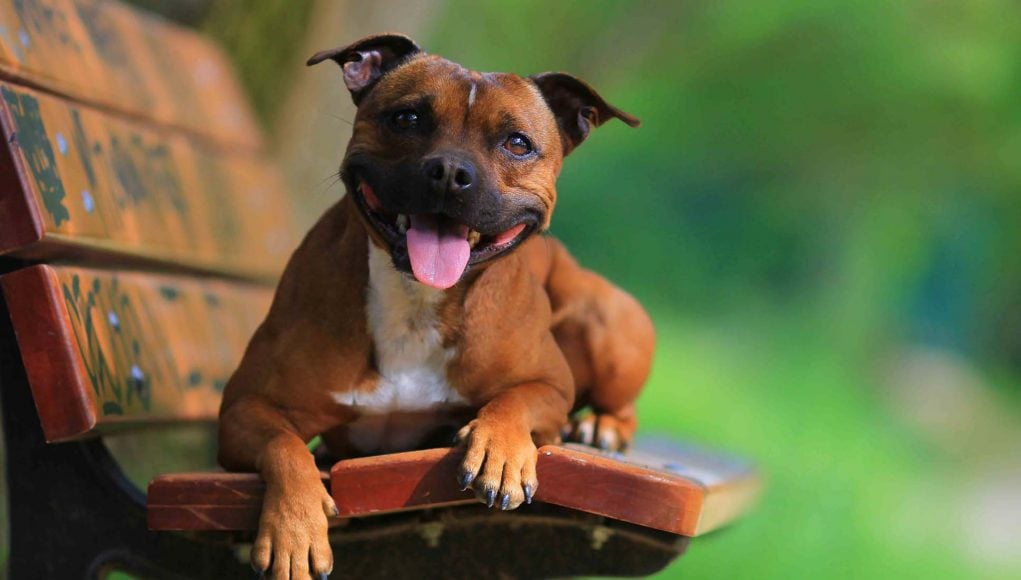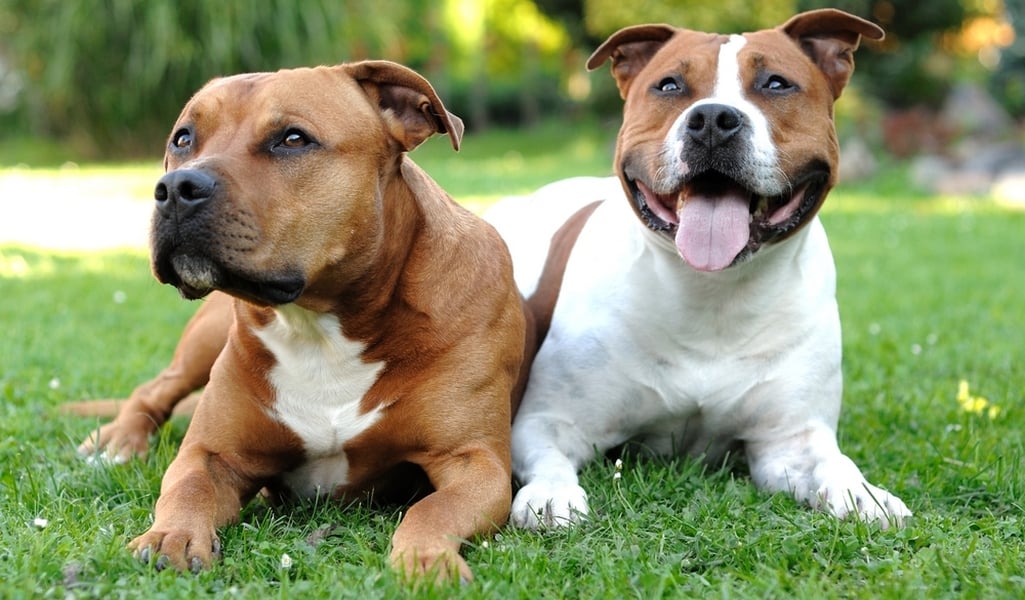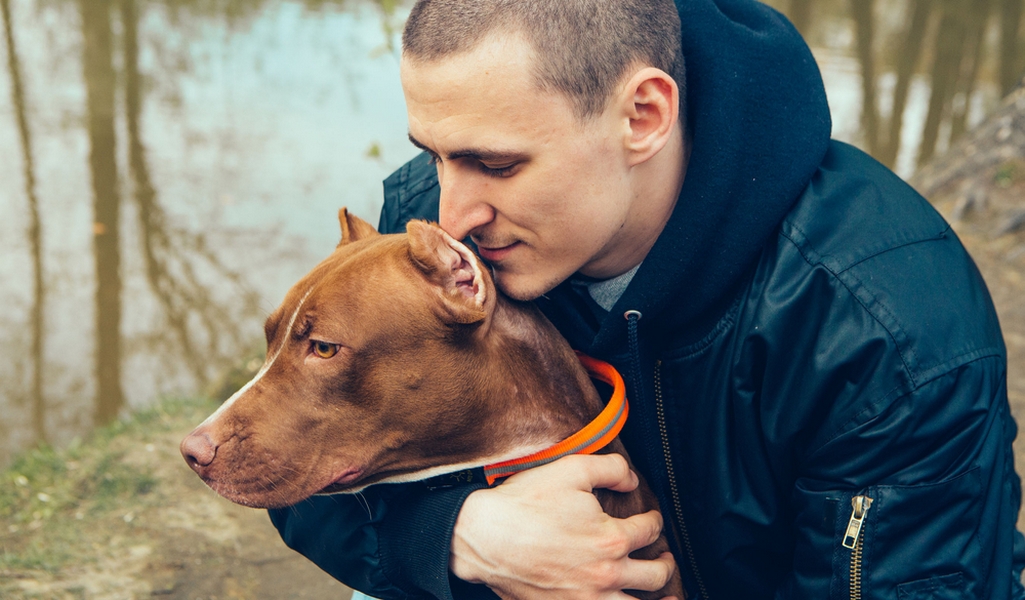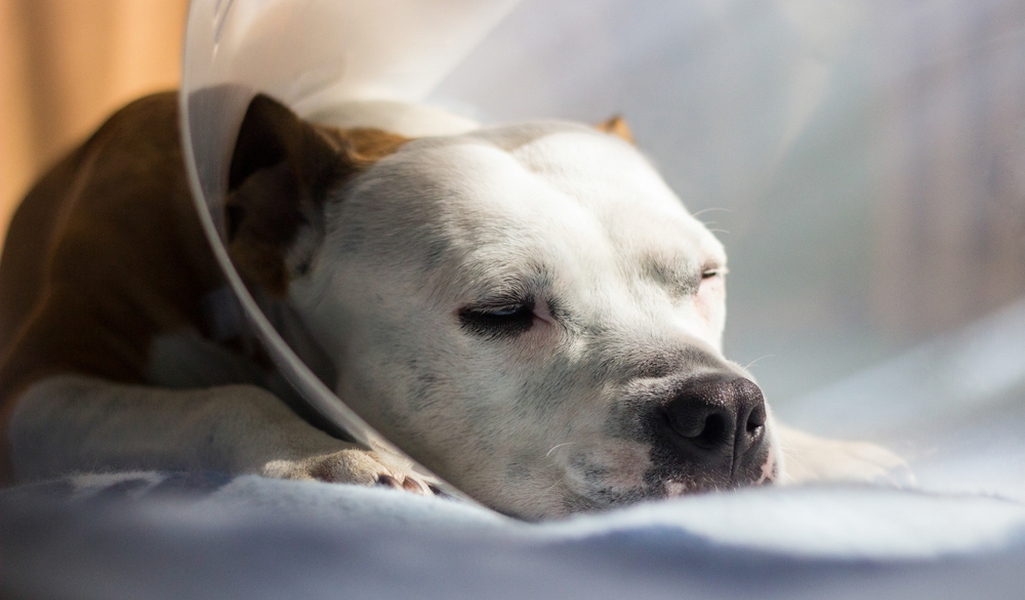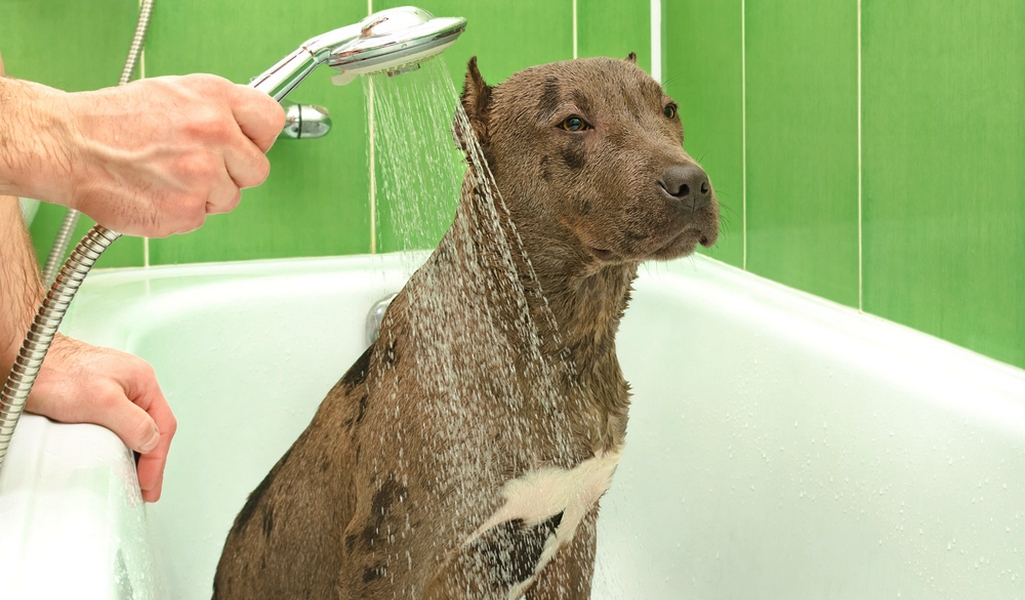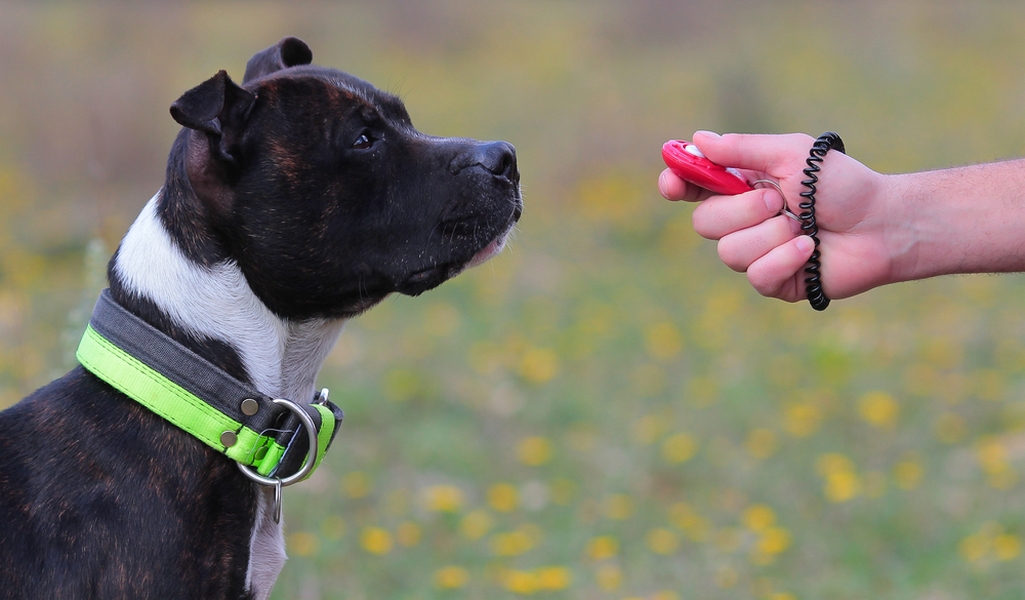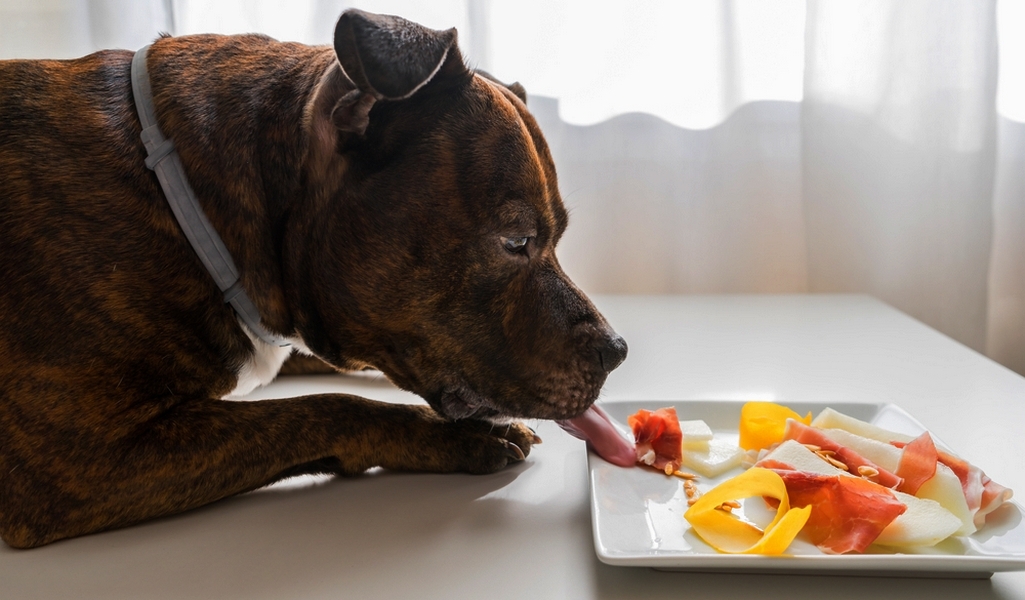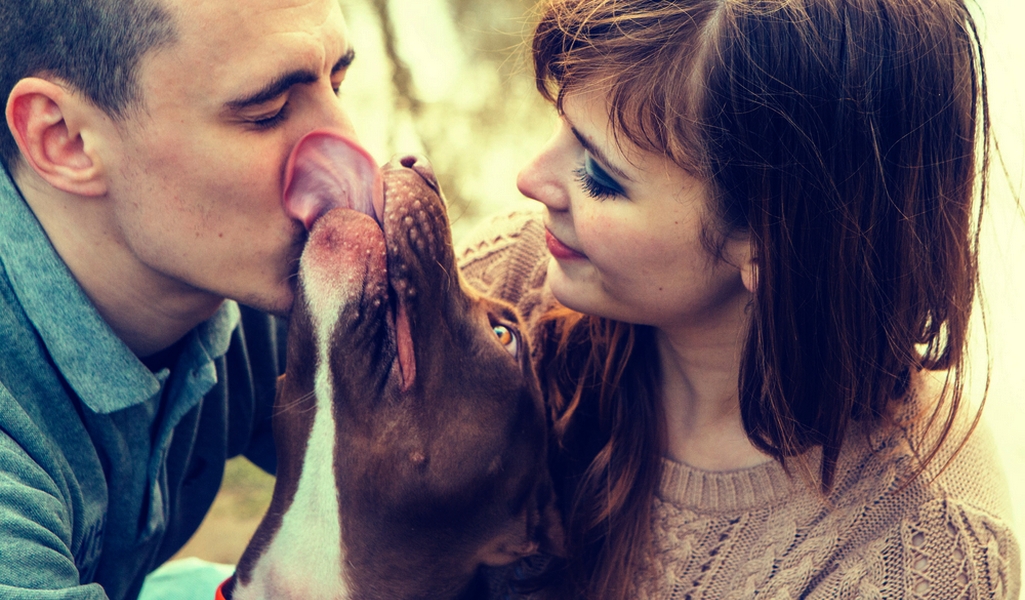Table of Contents
- Main Characteristics of Staffordshire Bull Terriers
- Best-Known Bulldog Facts
- Staffordshire Bull Terrier History
- Staffordshire Bull Terrier’s General Health and Common Ailments
- How To Groom A Staffordshire Bull Terrier
- How To Train Staffordshire Bull Terriers
- What To Feed Staffordshire Bull Terriers
- How Are Staffordshire Bull Terriers with Children?
- Where To Adopt Staffordshire Bull Terriers and Staffordshire Bull Terrier Puppies?
- Staffordshire Bull Terrier: What to look out for?
The Staffordshire Bull Terrier, also fondly known as a Staffie, is the 82nd most popular dog in the United States and the 5th most popular dog in the United Kingdom. This loving dog has been given a bad rap because it is a member of the Pit Bull family, but you'll soon see that this book should not be judged by its cover.
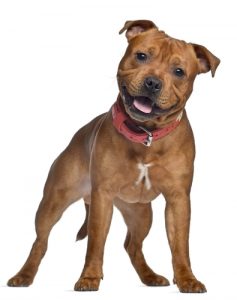 It's true that these dogs were bred to be fighting dogs, but those days are long gone. Now, they are known for their intelligence, love of family, and ability to be great companion animals. Their appearance can be a bit intimidating, with their strong, muscular body and intense stare, but you'll be surprised to find out that they are gentle and affectionate.
It's true that these dogs were bred to be fighting dogs, but those days are long gone. Now, they are known for their intelligence, love of family, and ability to be great companion animals. Their appearance can be a bit intimidating, with their strong, muscular body and intense stare, but you'll be surprised to find out that they are gentle and affectionate.
Fans of this breed love the Staffies' medium build and short coat. These dogs are energetic and are great companions for daily walks, runs, or hikes. Staffordshire Bull Terriers are smart, which makes them easy to train. This athletic breed is happy to take part in activities that are both mentally and physically engaging. You won't want to leave them unattended for long, though.
Intelligent breeds like this one tend to get bored easily. If left alone outside, there is a good chance your Staffie will find something to entertain himself. This may mean chasing a squirrel or following a neighbor on their daily walk. If left alone inside before properly house-trained, Staffordshire Bull Terriers are known to be destructive.
Main Characteristics of Staffordshire Bull Terriers
This medium-sized dog just wants to be a member of the family. Staffies are highly devoted and loyal to their family above all other things. If this dog senses danger, he will guard his family by any means he believes necessary.
Staffordshire Bull Terriers are full of energy and can keep up with you all day long. After they’re done playing, they’ll enjoy relaxing with you on the couch watching a movie. These dogs just want to be wherever you are, doing whatever you are doing.
When training or playing, you will find that these dogs are full of energy and just want to play. They can be a bit stubborn and want things their way, but with a gentle yet firm hand, you can teach them the ropes quickly. Once they know the line, they will be great playmates for you and the kids. They can be very gentle, even when they’re rough-housing.
Size of Staffordshire Bull Terriers
Staffordshire Bull Terriers are medium-sized dogs. On average, they will range from 14-16 inches high at the shoulder. This compact dog packs a lot of muscles in their little form. They are able to withstand toddlers' play and enjoy good, hard, and rough play with their owners. Staffies can weigh between 24 to 38 pounds. Like most breeds, females are usually smaller than their male counterparts.
Lifespan of Staffordshire Bull Terriers
Many things can affect how long your companion will stay with you, including how well he is exercised, how much he eats, and even his genetics. Most Staffordshire Bull Terriers will live to the age of 12-14 years old. Keeping your dog in optimal shape can add a couple of years to his life, and letting him become obese can take years off of it. The less strain that your pet has on his body, the happier and healthier he will be.
Physical Characteristics of Staffordshire Bull Terriers
The Staffordshire Bull Terrier has a lot of characteristics that are similar to other Bull Terriers. However, there are some differences that can be spotted. One of their most distinct differences is the shape of their ears. Staffies come in 14 different colors, including black, blue, white, fawn, brindle, or a combination of these. There are no markings that will keep them apart from any breed.
Staffordshire Bull Terriers have broad skulls with very pronounced cheeks. They have a short fore-face and a black nose. Pink, also known as a Dudley, is considered a flaw in the standards. Their eyes should be a dark color, although they may reflect the color of their coats. They’ll be round and medium-sized and set into their head so that they look straight ahead.
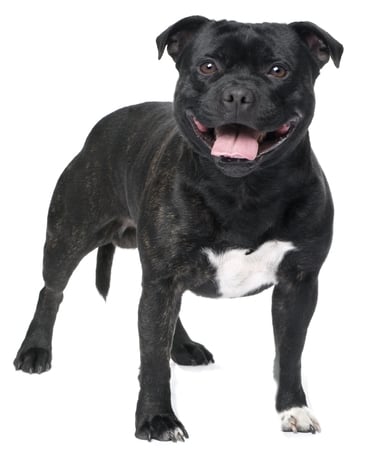 Staffies' ears are one of their most distinct features. They should be half-pricked and not overly large. Their ears should not be fully raised, nor should they be fully drooped. This breed needs to have a muscular neck in order to hold up their large heads. Their necks are usually short and widen at the base where it attaches to their shoulders.
Staffies' ears are one of their most distinct features. They should be half-pricked and not overly large. Their ears should not be fully raised, nor should they be fully drooped. This breed needs to have a muscular neck in order to hold up their large heads. Their necks are usually short and widen at the base where it attaches to their shoulders.
RELATED: Beagle Breed Profile
They have very compact, muscular bodies. Their ribs are rather wide, and their hind ends taper down at the waist. Their tails are medium length and have a slight curl to them, commonly related to an “old-fashioned pump handle.”
The Staffordshire Bull Terrier's legs are rather wide-spaced, with the feet turned out a bit. It is acceptable by the standards to have the dew claws removed. The Staffordshire Bull Terrier has a short, sleek coat. With regular grooming, their coat will be nice, shiny, and healthy-looking.
Living Arrangements for Staffordshire Bull Terriers
Staffordshire Bull Terriers are medium-energy dogs, but as long as they are well exercised, they can live in almost any environment. They make great companions when in the city, as long as when you go out for your walks you make sure your dog is on a leash.
It is not suggested and strongly discouraged to take your Staffie anywhere off leash or to a dog park.
When living in the suburbs, make sure to have your dog in a fenced-in yard. An electronic fence is not enough for a Staffordshire Bull Terrier. With their high threshold for pain and their high prey instinct, these dogs may pass over the boundary without stopping at the electronic fence. The other downside to these fences is that they do not prevent other animals from coming into your yard, and if it’s another dog, cat, or small animal, your Staffie will go after it.
These dogs are great for anyone who lives a moderately active life and will have lots of time to have their companion by their side. They are also great for young families with small children. Most Staffordshire Bull Terriers are most content when they live on their own. If you wish to have other animals in your house, make sure to socialize your puppy right away when he comes home. This will help him to adopt these other animals into his pack.
Staffordshire Bull Terriers are definitely a family dog. They love to be with their humans, in the house, out on a walk, or even out for a drive. Wherever you go, they want to be right beside you. They are not meant to be left alone for long periods of time, if they are, don’t be surprised when you come home to things being chewed up, they were bored and had to entertain themselves.
Socialization of Staffordshire Bull Terriers
Staffordshires love people. They were bred centuries ago to fight against other animals but to adore their handlers. These traits have continued in the Staffordshire Bull Terriers that we know and love now. Your Staffordshire Bull Terrier will be great around all humans, so they don’t make great guard dogs.
However, their loving attitude will not always go toward other animals. If you want your Staffordshire Bull Terrier to be social with other animals, make sure to have him around many other animals from the time he's a young pup.
Best-Known Bulldog Facts
Staffordshire Bull Terriers are well known for finding ways to entertain themselves. If they’re not kept mentally and physically stimulated, they will do it for themselves, which usually means that you will find them in a land mine of a yard that looks like it just went through a battlefield. They love to dig and won't think twice about tearing up your front yard.
They are also little escape artists. These dogs will dig a hole under their fence and escape out that way. To avoid this, either base your fence on cement or use chicken wire at the base of the fence to help keep them in.
Staffordshire Bull Terriers are the smaller cousin to the American Staffordshire Terrier.
One of the main reasons Staffordshire Bull Terriers like escaping their yard is to chase after smaller animals, usually the neighborhood cat. For centuries, they were bred to chase after smaller prey. This is why, in the Victorian age, they were used as ratters. With their compact bodies and agile movements, Staffies are the perfect specimen for chasing down those smaller animals.
Staffordshire Bull Terriers are members of the Pit Bull family. They were bred from Bulldogs and Terriers a couple of centuries ago. As such, they have a very powerful bite and lower jaw. They also have a tenacious obsession with chasing smaller animals.
This has made most Pit Bull breeds banned in many countries, cities, and municipalities. Before adopting or purchasing your Staffordshire Bull Terrier, make sure to check with your local government on the rules regarding your Staffie. This will help to protect your dog from being needlessly seized and destroyed.
There are many countries that have excluded the Staffordshire Bull Terrier from the Pit Bull ban. Some of these countries include Britain, Australia, and New Zealand. Unfortunately, the United States has not followed suit. Staffordshire Bull Terriers are included in all Pit Bull bans that are set up in the U.S.
RELATED ARTICLE: How to Train Your Pitbull
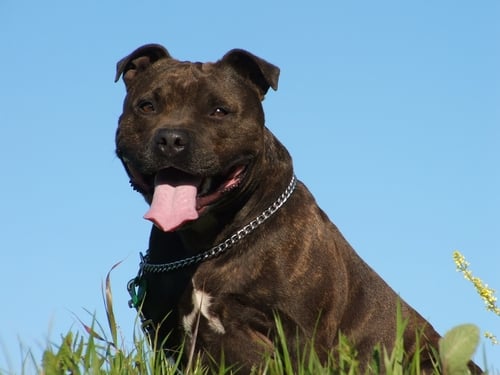 If you think that just because Staffordshire Bull Terriers are a member of the Pit Bull family, they’d be a great guard dog, you’d be wrong. They were bred to be affectionate towards humans, which means they’re more likely to want to play with a thief than to guard the jewelry. They will, however, let you know when someone comes into the yard. They will bark as the intruder approaches to get a pat.
If you think that just because Staffordshire Bull Terriers are a member of the Pit Bull family, they’d be a great guard dog, you’d be wrong. They were bred to be affectionate towards humans, which means they’re more likely to want to play with a thief than to guard the jewelry. They will, however, let you know when someone comes into the yard. They will bark as the intruder approaches to get a pat.
These dogs may work as guard dogs only because the look of them will scare off any would-be thief. Without knowing the dog and their temperament, that would-be thief may not think it’s worth the risk.
Staffordshire Bull Terrier History
Staffordshire Bull Terriers, like their cousins, have a bloody past. They were used to fight each other, other dogs, rats, and anything else their handlers could think to pit them up against. The breed was born in England in the early 1800s when Bulldogs and Mastiffs, also known as British Terriers, were bred together. The mix of these breeds created these powerful and compact fighting machines, which were then known as the Pit Bull Terrier.
In the 1800’s, the Staffordshire Bull Terriers got their big début fighting in the pits. Working-class men, especially coal miners, would use these dogs against each other, oftentimes fighting to the death. When not being set up against another dog, they would be put up against other animals.
With their strong jaws and muscular body, they were a force to be reckoned with. Many of these fights would continue in secrecy since dog fighting had been outlawed in 1835. In 1860, James Hinks crossbred the Old Pit Bull Terrier (what is now known as the Staffordshire Bull Terrier) and created the all-white English Bull Terrier.
In 1935, The Staffordshire Bull Terrier joined the ranks of dogs recognized by the Kennel Club of England. They were also involved in their first club show in this year. It took place at the Cradley Heath in the West Midlands. 60 dogs, males, and females, were entered into this show.
In 1939, the Staffordshire Bull Terrier won its first awards in the Kennel Club shows. Both male and females won in this year, the winners were Lady Eve and Gentleman Jim. In 1974, the breed was included in the American Kennel Club.
Staffordshire Bull Terrier’s General Health and Common Ailments
Staffordshire Bull Terriers are a generally healthy breed. There are very few common ailments associated with this breed, although, like all of us, there are some genetic issues that you should be aware of.
Although not normal, there are some cases of Staffies getting PRA (Progressive Retinal Atrophy) and Juvenile Cataracts. Another issue with the eyes is distichiasis, which is when the eyelashes are inverted and can irritate the cornea. This can be corrected with surgery if it’s really affecting your dog.
Early onset deafness is known to happen to Staffordshire Bull Terriers as well. Unfortunately, there’s not much that can be done about this. Common issues with this breed can also include cleft palate and an elongated soft palate. This is detected at birth and if the issues are too severe, most breeders will put the pups down rather than make them suffer. Issues with the palate can make it hard for the dog to be able to breathe, but most of these issues can be corrected with surgery.
Staffordshire Bull Terriers are known to have demodectic mange. If you find that this is the case, talk with your Veterinarian about what your options are in order to correct it. Proper nutrition, baths and brushing will help to keep the coat clean, shining and healthy.
Due to the shape of their body, it’s very possible for your Staffordshire Bull Terrier to have hip or elbow dysplasia. Most of these issues can be found in the puppy, but will be more noticeable once your dog turns about 2. If you adopt a new puppy, you should be sure that the breeder has screened for these issues.
How To Groom A Staffordshire Bull Terrier
Staffordshire Bull Terriers have a short, slick coat, but they still shed. In order to keep their shedding down, make sure to brush them once or twice a week. Using a soft curry brush or shedding tool should be sufficient for this breed. Remember that during the change of the seasons, your dog will shed more often. To keep the hair off your floor, furniture, and clothes, brush them 2-3 times a week.
Ears
Their ears are very easy to care for. Periodically check them to see if there’s any wax buildup inside, and if so, wipe it away with a warm cloth. If you find that there is a lot of excess build-up, you can use a cotton swab. Never go into the ear canal. This can cause severe issues to your dog's hearing.
The Staffordshire Bull Terrier's ears are half drooped. This means that normally, the air is able to get inside the ear to help dry them. This will help with the amount of wax that builds up, as it will dry up and fall out. Also, the amount of water that will stay in their ear will be minimal. It will be able to drain out or dry up.
Nails
Your Staffordshire Bull Terrier may not be able to wear his own nails down with just his exercise. Make sure to clip or grind the nails on a regular basis. You should not be able to hear the nails go click, click, click as your dog walks through the house.
RECOMMENDED READ: Dog Grooming Supplies 101: The Ultimate Buyers' Guide
If his nails become too long, this can cause them to crack or break. Even worse is having them get caught on something and rip it off. This will mean a trip to the vet to get stitches, at the very least. The best way to get your pet used to having his nails trimmed is by starting when he's a puppy. If you haven't done that or you've adopted an adult Staffie, you may want to seek the help of your veterinarian or a professional groomer.
Teeth
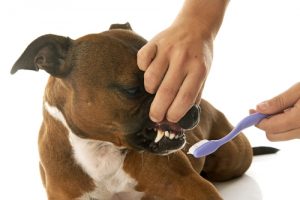 Oral care is very important to helping your dog keep all of his teeth. You can brush his teeth on a regular basis and also use teething products to keep plaque build-up down in between brushings. Working away the extra plaque and grime that gets stuck on their teeth will help to keep them healthy.
Oral care is very important to helping your dog keep all of his teeth. You can brush his teeth on a regular basis and also use teething products to keep plaque build-up down in between brushings. Working away the extra plaque and grime that gets stuck on their teeth will help to keep them healthy.
Staffordshire Bull Terriers have jaws that are strong enough to be able to tear through anything that you give them. They like to chew, so make sure to have lots of things around that they are able to work on. Stuffed toys will be quickly destroyed, so you'll need to spend a little money on some high-quality dog toys for aggressive chewers.
Obesity
Obesity is a very easy problem to keep in check, but it's also one of the most common health conditions in canines. Making sure that your dog gets an adequate amount of exercise and not an excessive amount of food will make sure that he stays at a healthy weight. If your Staffie is too heavy for their frame, it can cause even more joint issues. Making it hard for him to walk and get around.
How To Train Staffordshire Bull Terriers
Staffordshire Bull Terriers need to start their training from a very early age. As soon as you bring your dog home, you should start his training. Do not wait until after they have turned 6 months old to begin working with your dog, or he will most likely be set in his ways, and it will be much more difficult to train him.
Staffies can become very stubborn and stuck in their ways. You need to make sure that your dog knows who the Alpha of the family is and fast. This will make the rest of his training easier. I’m sure you’ll still find streaks of his stubbornness shine through, as this breed enjoys testing boundaries.
This is not the type of dog for inexperienced or first-time dog owners.
Make sure to stay patient and relaxed when working with your Staffordshire Bull Terrier. The energy that you put into his training will pass over into your Staffie. If you’re stressed out, your dog will become stressed out and not able to respond properly. Calm with an authoritative command will get through to a Staffie much faster.
RELATED: Top 10 Best Dog Training Collars Safe for Dogs
If you plan on having your Staffordshire Bull Terrier around other animals, make sure to start socializing him as soon as you come home. They are known to chase smaller prey, but Staffordshire Bull Terriers that have grown up with other animals can be very loving towards their friends.
Mental stimulation can be a great way to train a Staffordshire Bull Terrier. Doing activities like agility or obedience training with your dog can really improve their eagerness to listen and learn new tricks. Keep working with your dog and being patient while giving lots of praise.
Exercise
Daily exercise is extremely important for this breed. You need to keep the Staffordshire Bull Terrier happy and exercised if you want to have a happy home. It’s very important to not exercise in extreme heat or cold since they are susceptible to hypothermia and heat exhaustion. Keep your activities to temperature-appropriate activities.
Try to do your play times outside in cool to warm temperatures and play indoors with central cooling or heating during the extreme temperatures.
There are many exercises that you and your Staffordshire Bull Terrier can enjoy together. They like a lot of rough-housing, playing tug-of-war, and mentally stimulating games such as agility and obedience. When playing rough with your dog, make sure that he knows his boundaries and when he crosses the line.
Leash walks are great for both you and your dog. Three half-hour walks a day is ideal. Make sure to keep your dog on a leash at all times to help keep him and others safe. Since you never know how he is going to be around strange dogs, it’s very important to control those situations.
Make sure that you have your dog trained well to walk on a leash since this breed is so strong. It’s very important that you are always in control and that your dog is not going to be overpowering you. Dog parks are not recommended. Other dog interactions are not able to be controlled, so to keep your pet and everyone else around safe, avoid these situations.
What To Feed Staffordshire Bull Terriers
Healthy nutrition is very important to keeping your Staffordshire Bull Terrier lean, trim, and healthy. When Staffies overeat, they can become obese, which causes a lot of strain on their joints and organs. This will increase their chances of having hip or elbow dysplasia.
Keep your Staffie to just dog food (the higher the grade, the better), and keep the table scraps away. Most dog food manufacturers have specific types of products for different breeds, or at least for a small dog versus a big dog. Try to get food for small to medium dogs. You’ll also want to watch out for the amount of fillers that are in the food. Go for meats over grains when picking your food.
Best Dog Food for Staffordshire Bull Terriers
Choosing the best food for Staffordshire Bull Terriers is crucial, as it will meet your pet's unique individual nutritional needs. A quick conversation with your vet will teach you about the proper nutritional requirements of a Staffie and which canine diet may be best for your pet. Keep in mind that all Staffordshire Bull Terriers will have different nutritional needs depending on their weight, age, and any health conditions they may have.
Here are quick picks for the best dog food for Staffordshire Bull Terriers:
- Earthborn Holistic Great Plains Feast Grain-Free Dry Dog Food
- Merrick Grain-Free Recipe Dry Dog Food
- Farmina Natural and Delicious Grain-Free Formula Dry Dog Food
- Pioneer Naturals Grain & Potato Free Formula Dog Food
- Instinct Raw Boost Grain-Free Dry Dog Food
You can find more information on the general best dog food brands in this review.
How Are Staffordshire Bull Terriers with Children?
In the United Kingdom, Staffordshire Bull Terriers are nicknamed “nanny dogs.” They are extremely patient and gentle with children, and this breed is sturdy enough to be able to be a great playmate for your children. Most will even enjoy a good game of dress-up.
Although they are so good with kids, you should never leave your small children alone with any dogs. They should not be used as a substitute babysitter. Make sure that play between small children and dogs is always supervised to keep everyone safe. Teaching your children how to approach and play with all dogs is very important.
Where To Adopt Staffordshire Bull Terriers and Staffordshire Bull Terrier Puppies?
Before even looking into adopting or purchasing a Staffordshire Bull Terrier, make sure to check on the local breed-specific bans with your regional government. This will help to prevent the needless seizure and destruction of your family pet.
There are three different ways to acquire your new Staffordshire Bull Terrier. You can go through a breeder, an adoption shelter, or through clubs.
Breeder
Looking for a reputable breeder should be of your highest concern when looking to purchase a new puppy. Look for someone who is interested in you and your family and how you live. You’ll want a breeder who is interested in the welfare of their pups and where they are going to be placed.
Reputable breeders will also make sure that the parents are well taken care of, that the pups are well-socialized, and that the litters are in a clean and safe environment. Your breeder should be open and honest about the different diseases that are genetic in Staffordshire Bull Terriers, and they should have several different tests done on the puppies before you get them.
These tests should be registered with the Orthopedic Foundation for Animals (OFA). The tests include hip dysplasia and elbow dysplasia. They should also have their eyes tested through the Canine Eye Registry Foundation.
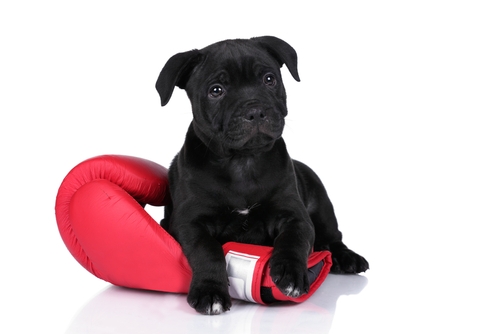 You can check that these tests have been done and what their results are on the OFA website (offa.org). Keep in mind that all results are available on the OFA website, not just the passing tests, so make sure to check what the score is before adopting your new puppy.
You can check that these tests have been done and what their results are on the OFA website (offa.org). Keep in mind that all results are available on the OFA website, not just the passing tests, so make sure to check what the score is before adopting your new puppy.
You can find many reputable Breeders that are registered with the American Kennel Club here.
Adoption Shelter
Unfortunately, for many different reasons, Staffordshire Bull Terriers cannot always stay in their home. This does not mean that they are bad dogs or even that it’s a problem with the dog. Some could have come into the shelter due to a breakdown in the home or the passing of a loved one.
Many of these dogs are great and just need a new forever home, and let’s face it, you can skip the puppy stage by doing this. There are many great sites that you can go to and find your new companion, and of course, you should try to find out as much information as you can about these dogs.
You’ll also be able to see if there are any issues in older dogs by doing this. Hip dysplasia and other genetic defaults will be more prominent in an older dog. Some sites to check out include:
Clubs
The SBT Club of America is a great place to gather information on where to find and acquire your new Staffordshire Bull Terrier. They will also help you with any questions that you may have about your new dog or about any breeders you may consider working with. They are an excellent resource to find reputable breeders or dogs who are in need of help.
Staffordshire Bull Terrier: What to look out for?
 When acquiring your new puppy, you want to, first and foremost, stay clear of puppy mills. These are places that are just in it for the money and don’t actually care for the well-being of the dogs or where they are going to be placed. Other signs of puppy mills are how the dogs are housed and how much litter is on the go at any given time.
When acquiring your new puppy, you want to, first and foremost, stay clear of puppy mills. These are places that are just in it for the money and don’t actually care for the well-being of the dogs or where they are going to be placed. Other signs of puppy mills are how the dogs are housed and how much litter is on the go at any given time.
Be wary of breeding facilities when there is no paperwork available for your new dog (unless you are getting a shelter dog under certain situations). All new puppies should have their shots and be tested by vets and professionals before they can be sold.
Puppies should never be taken away from their mothers before they reach the age of 8 weeks. They need this time to learn proper socialization skills and also have time for all of their checkups. Make sure to visit your vet within days of getting your new dog; they will be able to go over them and check their health.


